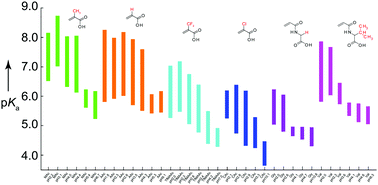Wide-range pKa tuning of proton imprinted nanoparticles for reversible protonation of target molecules via thermal stimuli†
Abstract
pKa tuning of Brønsted acids in synthetic nano-materials is of great importance for the design of ion exchange and bio-/molecular-separation media and polymer catalysis. It has been reported that hydrogel nanoparticles with carboxylic acids that show large and reversible pKa shifts in response to thermal stimuli can be prepared by copolymerization of N-isopropylacrylamide (NIPAm), acrylic acids (AAc) and N,N′-methylene bisacrylamide (BIS) via the proton imprinting polymerization process. However, the reported range of pKa shifts is limited to the range of 5.3 to 7.5. In this study, we report a procedure to prepare proton imprinted NPs that show pKa shifts in the tuned pKa range and demonstrate applications of the NPs. pKa values ranging from 4.3 to 8.7 were achieved by designing the structure of monomers containing carboxylic acids and applying the proton imprinting procedure. It was demonstrated that proton-imprinted NPs with different pKa values could be used for the reversible and selective protonation of target molecules which have specific pKa values. Our results establish the generality of the proton imprinting procedure and provide a guide for designing stable and inexpensive materials for sophisticated purification processes.



 Please wait while we load your content...
Please wait while we load your content...